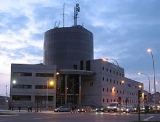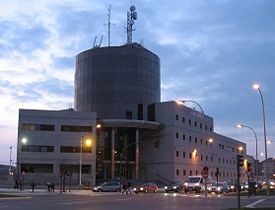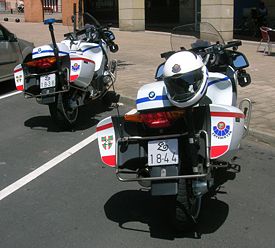
Ertzaintza
Encyclopedia

Basque Country (autonomous community)
The Basque Country is an autonomous community of northern Spain. It includes the Basque provinces of Álava, Biscay and Gipuzkoa, also called Historical Territories....
, one of the autonomous communities of Spain
Autonomous communities of Spain
An autonomous community In other languages of Spain:*Catalan/Valencian .*Galician .*Basque . The second article of the constitution recognizes the rights of "nationalities and regions" to self-government and declares the "indissoluble unity of the Spanish nation".Political power in Spain is...
. An Ertzaintza member is an ertzaina (erts̻aɲa).
Origins
The origins of the current Ertzaintza, as a police force of the part of the Basque Country under Spanish jurisdiction, can be traced back to the old municipal militiaMilitia
The term militia is commonly used today to refer to a military force composed of ordinary citizens to provide defense, emergency law enforcement, or paramilitary service, in times of emergency without being paid a regular salary or committed to a fixed term of service. It is a polyseme with...
s, which were popular organizations at the service of local bodies, created to satisfy the need for public safety. But it was not until the 19th century when the almost permanent police corps of a professional nature were created.
It was a response to the banditry
Banditry
Banditry refers to the life and practice of bandits which the Oxford English Dictionary defines as "one who is proscribed or outlawed; hence, a lawless desperate marauder, a brigand: usually applied to members of the organized gangs which infest the mountainous districts of Italy, Sicily, Spain,...
caused by the continuous social and political upheaval occurring from the end of the 18th century and well into the 19th. The decisive argument for its configuration was the First Carlist War
First Carlist War
The First Carlist War was a civil war in Spain from 1833-1839.-Historical background:At the beginning of the 18th century, Philip V, the first Bourbon king of Spain, promulgated the Salic Law, which declared illegal the inheritance of the Spanish crown by women...
, when the Miqueletes of Biscay
Biscay
Biscay is a province of Spain and a historical territory of the Basque Country, heir of the ancient Lord of Biscay. Its capital city is Bilbao...
and Guipuzcoa and the Miñones of Alava
Álava
Álava is a province of Spain and a historical territory of the Basque Country, heir of the ancient Lord of Álava. Its capital city is Vitoria-Gasteiz which is also the capital of the autonomous community...
commenced their activities.
Once the urgencies of the war were overcome, the Spanish government
Spanish Government
Spain is a constitutional monarchy whose government is defined by the Constitution of Spain. This was approved by a general referendum of the people of Spain in 1978...
attempted to recover the functions carried out by these regional forces and transfer them to the Civil Guard
Civil Guard (Spain)
The Civil Guard is the Spanish gendarmerie. It has foreign peace-keeping missions and maintains military status and is the equivalent of a federal military-status police force. As a police force, the Guardia Civil is comparable today to the French Gendarmerie, the Italian Carabinieri and the...
, which was created in 1844. Nevertheless, due to difficulties encountered when recruiting forces for this corps in the Basque provinces, plus the pressure posed by the other regional Governments, the very same regional forces were able to more or less carry on with their task.
After Carlist Wars
After the end of the Second Carlist WarSecond Carlist War
The Second Carlist War, or the War of the Matiners or Madrugadores , was a short civil war fought primarily in Catalonia by the Carlists under General Ramón Cabrera against the forces of the government of Isabella II...
(1876), the Spanish government wished to curtail the regional autonomy. The Basque police forces had to adapt to this new centralist tendency, and these changes mostly manifested themselves in a reduction of personnel & operational capabilities
When the Second Spanish Republic
Second Spanish Republic
The Second Spanish Republic was the government of Spain between April 14 1931, and its destruction by a military rebellion, led by General Francisco Franco....
was proclaimed in 1931, political activity surged and so did the Basque claim to re-establish regional liberties that had been abolished in 1876. Thus, various projects for the Autonomy Statute were promoted.
On October 1, 1936, during the Spanish Civil War
Spanish Civil War
The Spanish Civil WarAlso known as The Crusade among Nationalists, the Fourth Carlist War among Carlists, and The Rebellion or Uprising among Republicans. was a major conflict fought in Spain from 17 July 1936 to 1 April 1939...
, the Basque Statute of Autonomy come into force, leading to the establishment of an autonomous government with actual authority over the provinces of Biscay and Guipuzcoa.
One of the priorities of the new government was the re-establishment of public order.
The Basque Interior Minister Telesforo Monzón
Telesforo Monzón
Telesforo de Monzón y Ortiz de Urruela was a writer, politician and nationalist Basque leader....
set up several institutions, such as the International Police Force, the Maritime Police and the Public Order Body. Their main task was the creation of a police force named Ertzaña (a Basque neologism for "People care"), with on foot and motorised corps (Igiletua), totalling joint forces of around 1,500 agents. Its headquarters were in Bilbao, at the Ibaigane Palace (currently the headquarters of Athletic Bilbao
Athletic Bilbao
Athletic Club, also known as Athletic Bilbao, is an association football club from Bilbao in Biscay, Spain. The club has played in the Primera División of La Liga since its start in 1928. They have won La Liga on eight occasions...
).
When the war on the Basque front concluded, the Ertzaña was dissolved, and Franco's
Francisco Franco
Francisco Franco y Bahamonde was a Spanish general, dictator and head of state of Spain from October 1936 , and de facto regent of the nominally restored Kingdom of Spain from 1947 until his death in November, 1975...
Nationalist regime pretended that this institution had never existed in the first place.
Having allied themselves with the losing Republican
Second Spanish Republic
The Second Spanish Republic was the government of Spain between April 14 1931, and its destruction by a military rebellion, led by General Francisco Franco....
side, Biscay and Guipuzcoa were considered "traitor provinces" and most of their autonomy was annulled.
However, since at the outbreak of the civil war Alava and Navarre
Navarre
Navarre , officially the Chartered Community of Navarre is an autonomous community in northern Spain, bordering the Basque Country, La Rioja, and Aragon in Spain and Aquitaine in France...
had thrown their lot in with the Nationalists, the Miñones and Miqueletes continued on duty, with assignments such as traffic patrols and custody of the regional institutions.
During Transition
After the Spanish transition to democracySpanish transition to democracy
The Spanish transition to democracy was the era when Spain moved from the dictatorship of Francisco Franco to a liberal democratic state. The transition is usually said to have begun with Franco’s death on 20 November 1975, while its completion has been variously said to be marked by the Spanish...
, the autonomous Basque Government was restored. Its government once again took up the spirit of the Ertzaña of 1936 to design, in 1980, the new autonomous police force of the Basque Country, the Ertzaintza (a more grammatical form). Previously, a Royal Decree re-established the "Forales" and the "Miqueletes" in Biscay and Guipuzcoa and gave a new configuration to the "Miñones" corps in Alava. These institutions were incorporated into the new Basque Police Force.
Because Navarre
Navarre
Navarre , officially the Chartered Community of Navarre is an autonomous community in northern Spain, bordering the Basque Country, La Rioja, and Aragon in Spain and Aquitaine in France...
, during the events surrounding Spain's 1978 Constitution, ended up with the status of Autonomous Community
Autonomous communities of Spain
An autonomous community In other languages of Spain:*Catalan/Valencian .*Galician .*Basque . The second article of the constitution recognizes the rights of "nationalities and regions" to self-government and declares the "indissoluble unity of the Spanish nation".Political power in Spain is...
and was not lumped in with the Basque autonomous community and its police force (Policía Foral
Policía Foral
The Chartered Police of Navarre is the regional police force for the chartered autonomous community of Navarre in Spain. It operates across the region, and was founded from a traffic police unit set up by the Provincial Council of Navarre in 1929....
) remains independent of the Ertzaintza.
Officers
The first officers were members of the Basque Nationalist PartyBasque Nationalist Party
The Basque National Party is the largest and oldest Basque nationalist party. It is currently the largest political party in the Basque Autonomous Community also with a minor presence in Navarre and a marginal one in the French Basque Country...
. Although the law required that Ertzaintza commissioned officers had to be previous members of the Spanish army or the State police forces, this was often ignored.


Statistics
The Basque Country has one of the highest ratios of police agents to population. Ertzaintza has taken the range of roles of the National Police and the Civil Guard., seventeen classes of agents have graduated from the Police Academy of the Basque Country, in Arkaute (Alava).
The Ertzaintza is currently a full-range police force, but for borders control.
The state police bodies have decreased their numbers in the Basque Country. Combating ETA
ETA
ETA , an acronym for Euskadi Ta Askatasuna is an armed Basque nationalist and separatist organization. The group was founded in 1959 and has since evolved from a group promoting traditional Basque culture to a paramilitary group with the goal of gaining independence for the Greater Basque Country...
and pressuring violent Basque nationalist organisations is also part of their remit.
Currently, the Ertzaintza counts on a staff of 7,500 agents, framed within five branches (1.Citizen Scurity and Operational Resources, 2. Traffic control, 3.Counter-terrorism, 4. Criminal Police, and 5.Internal affairs-Administrative) each of them specialized in a series of specific police tasks, and supported by the corresponding complementary services.
Units
- Citizen Security
- Citizen Security, rural patrol
- Traffic Unit
- Traffic Unit, motorcycle patrol
- Mobile Brigade, Mountain Rescue Unit
- Mobile Brigade, Diving Unit
- Mobile Brigade, Riot Control
- Mobile Brigade, Water Police
- UDE, Bomb Disposal Unit
- Berrozi: bodyguard, intervention and subsoil
- Helicopters Unit
- Canine Operational Group
- Drugs Group
- Computer Offences Group
- Personal Protection Group: bodyguards, gender violence, etc.
- Intelligence Group
- Gambling and Shows Group
Problems with ETA and controversies
Ertzaintza is not accepted by Communists, ETAETA
ETA , an acronym for Euskadi Ta Askatasuna is an armed Basque nationalist and separatist organization. The group was founded in 1959 and has since evolved from a group promoting traditional Basque culture to a paramilitary group with the goal of gaining independence for the Greater Basque Country...
and Batasuna
Batasuna
Batasuna was a Basque nationalist political party based mainly in Spain, where it was outlawed in 2003, after a court ruling declared proven that the party was financing ETA with public money. Batasuna is included in the "European Union list of terrorist persons and organizations" as a component...
, who deride it as zipaioak, ("Sepoy
Sepoy
A sepoy was formerly the designation given to an Indian soldier in the service of a European power. In the modern Indian Army, Pakistan Army and Bangladesh Army it remains in use for the rank of private soldier.-Etymology and Historical usage:...
s", an indigenous force serving the colonial power). As Ertzaintza took a more relevant role in the fight against ETA, it has become a target for them. It was soon infiltrated by ETA members. In the areas where support for ETA is higher, ertzainas are forced to reside elsewhere and commute to work.
Fourteen ertzainas have been killed or injured by ETA, sometimes being specifically targeted.
The Spanish government has had reservations about Ertzaintza. Spanish parties have often accused the Basque Home Office (always held by the Basque Nationalist Party) of being soft on the fight against ETA and its supporting party Batasuna
Batasuna
Batasuna was a Basque nationalist political party based mainly in Spain, where it was outlawed in 2003, after a court ruling declared proven that the party was financing ETA with public money. Batasuna is included in the "European Union list of terrorist persons and organizations" as a component...
. Two police officers of Ertzanintza said that former nationalist government give them orders to do not act against ETA members and its social environment. Because of infiltration, Ertzaintza is not allowed by the Spanish Ministry of the Interior
Ministry of the Interior (Spain)
The Ministry of Interior of Spain which historically could be known as Ministerio de la Gobernación, Ministerio del Orden Público, Ministerio del Interior y la Gobernación or Ministerio del Interior y Justicia is the executive branch responsible for policing, national security, and immigration...
to access the Interpol
Interpol
Interpol, whose full name is the International Criminal Police Organization – INTERPOL, is an organization facilitating international police cooperation...
intelligence network.
Lack of communication has occasionally led to shootings among police forces.
Recently some councillors of The Basque Country said that they have perceived a decrease of the pro-ETA menace because of the current important role of the Ertzaintza against terrorism.
Etymology
Ertzaña was a Basque neologism from the Biscayne forms erri ("people") and zañ ("guard").The generic Basque word for "police" is polizia.
Following the standardization of Basque in the 1960s
Batua
Standard Basque is a standardised version of the Basque language, developed by the Basque Language Academy in the late 1960s, which nowadays is the most widely and commonly spoken Basque-language version throughout the Basque Country...
, the name of the restored force became "Ertzaintza" from the respelled herri and zain (compare with artzain, "shepherd" from ardi + zain), with the suffix -tzain.
However to maintain a link to the past, the silent H was not included.
The Basque pop group Hertzainak chose their name prior to the re-establishment of the corps and applied the modern spelling rules.

